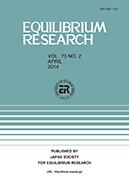All issues

Volume 73 (2014)
- Issue 6 Pages 477-
- Issue 5 Pages 313-
- Issue 4 Pages 187-
- Issue 3 Pages 117-
- Issue 2 Pages 47-
- Issue 1 Pages 1-
Volume 73, Issue 2
Displaying 1-6 of 6 articles from this issue
- |<
- <
- 1
- >
- >|
Educational Lecture Approach to intractable vertigo
-
Norihito Takeichi2014 Volume 73 Issue 2 Pages 47-54
Published: April 30, 2014
Released on J-STAGE: June 01, 2014
JOURNAL FREE ACCESSSpinocerebellar degeneration (SCD) is an inherited neurological disorder characterized by the slow degeneration of the brainstem and cerebellum. The Motor Ataxia Research Group has reported that there are more than 36,000 patients in Japan. Previously, SCD was classified by the clinical symptoms so that it was hard to make a distinct diagnosis. After the 1990s, SCD was identified genetically and has been classified into more than 60 different types. This classification has facilitated our approach to the restricted neuronal function of the brain stem and cerebellum. Usually the diagnosis comes after examination by a neurologist, which includes a physical exam, family history, MRI scanning of the brain and spine, and spinal tap. However, the patients frequently reveal unsteadiness of gait associated with nystagmus that could be also observed in the patients with peripheral vestibular impairment. For this, one third of the SCD patients visit otolaryngologists at their first hospital visit. For an accurate diagnosis, an eye movement examination is necessary. Brainstem and cerebellar lesions affect physiological eye movements, e.g., saccade, smooth pursuit and VOR suppression. Eye gains during those physiological eye movements in SCD patients are significantly lower than controls. Although it is not necessary for them to be an expert, otolaryngologists should understand the role of the brain stem and cerebellum, especially how they affect movements of the eye.View full abstractDownload PDF (773K)
Original articles
-
Mitsuo Sato, Katsumi Doi2014 Volume 73 Issue 2 Pages 55-60
Published: April 30, 2014
Released on J-STAGE: June 01, 2014
JOURNAL FREE ACCESSWe report herein on a case in which a vestibular neurectomy via the middle fossa approach was performed for intractable Meniere's disease. The patient had been treated first with conservative therapy, but her symptoms had not improved. She had undergone endolymphatic sac surgery three times. Since repeated vertigo attacks persisted after that, a vestibular neurectomy was planned. Although preoperative hearing demonstrated severe sensorineural hearing loss, the middle fossa approach was selected due to the expected higher possibility of control of the vertigo. Facial nerve monitoring was used to identify the vestibular nerve during the surgery. There were no postoperative complications like cerebrospinal fluid leakage and facial palsy. Two days after the operation normal walking was possible and the nystagmus disappeared in approximately two weeks. Six months after the operation, there was no vertigo attack.View full abstractDownload PDF (601K) -
Izumi Yahata, Hiromitsu Miyazaki, Kazuha Oda, Yoshitaka Takanashi, Tet ...2014 Volume 73 Issue 2 Pages 61-68
Published: April 30, 2014
Released on J-STAGE: June 01, 2014
JOURNAL FREE ACCESSWe investigated 254 vertiginous outpatients who visited our neuro-otological clinic from 2009 to 2011 regarding their diagnosis, age-distribution, sex-ratio, character of disequilibrium, the reason for visiting us, and the results of their equilibrium function examination. The ratio of males to females was 1: 2. The age-distribution showed a peak in the fifth to sixth decade for both sexes. Most patients were suffering from Meniere's disease (26.0%) and benign paroxysmal positional vertigo (BPPV) (22.8%). Fifteen patients (5.9%) were diagnosed as having psychogenic vertigo. The equilibrium function examination showed that canal paresis was a significant factor in Meniere's disease. Our results suggest that it is important for otolaryngologist to be equipped with knowledge about the psychiatric comorbidity in patients with vertigo.View full abstractDownload PDF (573K) -
Sakurako Komiyama, Haruka Nakahara, Yukiko Tsuda, Eriko Yoshimura, Tos ...2014 Volume 73 Issue 2 Pages 69-75
Published: April 30, 2014
Released on J-STAGE: June 01, 2014
JOURNAL FREE ACCESSWe report herein on 2 patients with superior canal dehiscence (SCD), who did not exhibit the typical sound- or pressure-induced vestibular signs of the condition. In these patients, ocular VEMP (oVEMP) testing using air-conducted sound (ACS) was found to be useful for selecting patients for CT scan of the temporal bone. The first patient was a 38-year-old woman. She presented with a complaint of episodic vertigo and right aural fullness. She showed air-bone gaps at low frequencies in pure-tone audiometry on the right. She did not show sound- or pressure-induced vestibular signs. She showed augmentation of amplitudes and lowering of thresholds of cervical VEMP (cVEMP) and oVEMP to ACS 500 Hz short tone bursts (STB) on the right. CT scan images revealed superior (anterior) canal dehiscence on the right. The second patient was a 47-year-old man. He visited our clinic due to autophony and dizziness. He showed normal pure-tone hearing. He did not show sound- or pressure-induced vestibular signs. He showed bilateral augmentation of amplitudes of cVEMP and oVEMP to ACS 500 Hz STB. CT scan images revealed bilateral superior canal dehiscence. Augmentation was more prominent in oVEMP than cVEMP. These results suggest that oVEMP 500 Hz STB of ACS is a good method for screening for SCD.View full abstractDownload PDF (537K)
Topics
-
Masahito Tsubota2014 Volume 73 Issue 2 Pages 76-78
Published: April 30, 2014
Released on J-STAGE: June 01, 2014
JOURNAL FREE ACCESSDownload PDF (285K) -
[in Japanese]2014 Volume 73 Issue 2 Pages 79-89
Published: April 30, 2014
Released on J-STAGE: June 01, 2014
JOURNAL FREE ACCESSDownload PDF (547K)
- |<
- <
- 1
- >
- >|